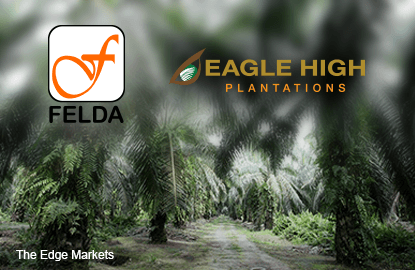
INDONESIA’s Rajawali Group has come out to deny accusations that its planned sale of a 37% stake in plantation company PT Eagle High Plantations Tbk to the Federal Land Development Authority (FELDA) for US$505.4 million (about RM2.25 billion) is pricey.
In an email response to questions from The Edge, Rajawali deputy managing director Satrio Tjai says, “FELDA is coming into Eagle High at the right time. We would like to remind you that the US$505.4 million factors in Eagle High as a whole company. We do think that taking into account all considerations, the deal is a win-win [for both Rajawali and FELDA] and is fairly valued.”
Over the past few weeks, detractors have been saying that although the price tag is considerably lower than Rajawali’s initial asking price of US$680 million in June 2015, it still prices Eagle High at IDR580 per share — higher than the IDR298 that the plantation company was trading at prior to FELDA’s offer.
To put things in perspective, Eagle High’s market capitalisation last Friday was about US$630 million.
Other than the high price tag, there are also concerns that FELDA will not have control of Eagle High as Rajawali will still have 37.06% equity interest after the sale.
Satrio says, “Eagle High has more than 320,000ha of land bank. Its total planted area, including nucleus and plasma, is about 150,000ha, with an average age of about eight years. Therefore, to achieve more favourable valuation to FELDA, only the planted nucleus of more than 125,000ha was used.
“Moreover, Eagle High’s young plantation profile, size of planted land, access to unplanted land bank for future growth, potential synergies, unique deal structure that gives FELDA board representations and other reserved matters should be factored in.”
He adds that within the next few years, Eagle High’s production will peak as indicated by an S curve, which would result in a huge increase in production, and costs will not increase as most of the heavy capital investments have already been made. This means that Ebitda (earnings before interest, taxes, depreciation and amortisation) should also increase strongly.
An S curve generally displays cumulative costs, labour hours or other quantities against time, and is generally flatter or flat at the beginning and end, and steep in the middle.
“At an average of about eight years, Eagle High is entering the vertical phase of the S curve as demonstrated by the sharp increase in production in the fourth quarter of 2016 as well as positive cash flow,” says Satrio.
He adds that in the next few years, Eagle High’s debt will decline as a result of the settlement of a substantial amount over the next two to three years, which would imply significant potential dividends.
While its fourth-quarter numbers have not been made public, Eagle High suffered a net loss of IDR300.35 billion (about RM100 million or US$22 million) for its nine months ended September 2016. Its gearing was at 1.32 times.
Satrio says there were other suitors from the region for the Eagle High stake, but declines to name them.
Save by subscribing to us for your print and/or digital copy.
P/S: The Edge is also available on Apple's AppStore and Androids' Google Play.